|
|
| Line 26: |
Line 26: |
| | =====Spectroscopy and HPLC===== | | =====Spectroscopy and HPLC===== |
| | | | |
| - | [[File:Beta carotene time2.jpg|300px|thumb|left|Beta carotene vs. Time for yeast strains 39, 128, 179, 201* | + | [[File:Beta carotene time2.jpg|300px|thumb|left|Beta carotene vs. Time for yeast strains 39, 128, 179, 201 |
| - | | + | refer: |
| - | *High-Level Production of Beta-Carotene in Saccharomyces cerevisiae by Successive Transformation with Carotenogenic Genes from Xanthophyllomyces dendrorhous
| + | High-Level Production of Beta-Carotene in Saccharomyces cerevisiae by Successive Transformation with Carotenogenic Genes from Xanthophyllomyces dendrorhous |
| | René Verwaal,1, Jing Wang,1 Jean-Paul Meijnen,1 Hans Visser,1,Gerhard Sandmann,2 Johan A. van den Berg,1, and Albert J. J. van Ooyen1*]] | | René Verwaal,1, Jing Wang,1 Jean-Paul Meijnen,1 Hans Visser,1,Gerhard Sandmann,2 Johan A. van den Berg,1, and Albert J. J. van Ooyen1*]] |
| | | | |
Results
The strains transformed with the caretenogenic genes are a bright orange color due to all the beta-carotene they produce, as beta-carotene is an orange pigment. We confirmed its presence via HPLC using a standard.
On a first visual comparison of growth on dough media vs YPD we did see a significantly slower growth on dough media than on YPD. This is to be expected considering there is a large excess of nutrients on the YPD plates. There was still significant growth on the dough media plates however, enough to show that it would be viable to use in bread.
Spectroscopy and HPLC
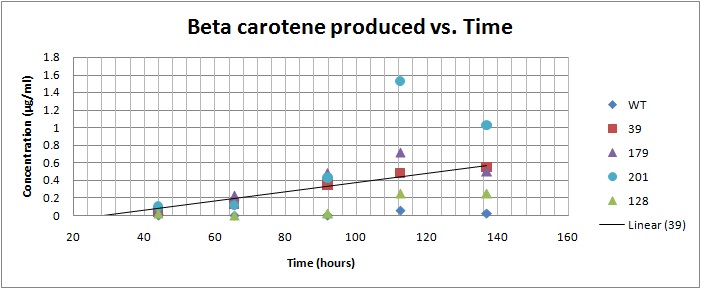
Beta carotene vs. Time for yeast strains 39, 128, 179, 201 refer: High-Level Production of Beta-Carotene in Saccharomyces cerevisiae by Successive Transformation with Carotenogenic Genes from Xanthophyllomyces dendrorhous René Verwaal,1, Jing Wang,1 Jean-Paul Meijnen,1 Hans Visser,1,Gerhard Sandmann,2 Johan A. van den Berg,1, and Albert J. J. van Ooyen1*
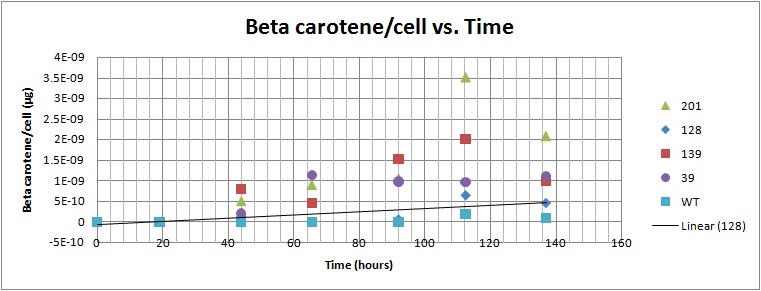
Beta carotene/cell vs. Time for yeast strains 39, 128, 179, 201
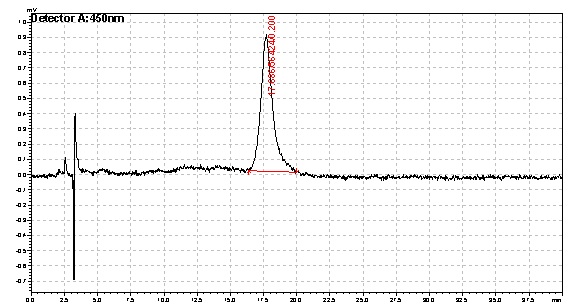
Beta carotene extracted from yeast strain 210
Based on the results of our Spectroscopy experiments measuring beta-carotene versus time and characterization by the use of HPLC, we can see that the production of beta-carotene over time increases at a (rate). The results of the HPLC confirm that the yeast cells are in fact producing beta carotene, as the absorption peak at 450nm corresponds to the absorption maxima of beta-carotene. Before running the samples on the HPLC, beta carotene was extracted from cell extract using hexane, as it would only isolate highly hydrophobic molecules, such as beta-carotene. As seen in following Spectroscopy and HPLC graphs, beta carotene production and characterization can be quantified.
Protein Purification
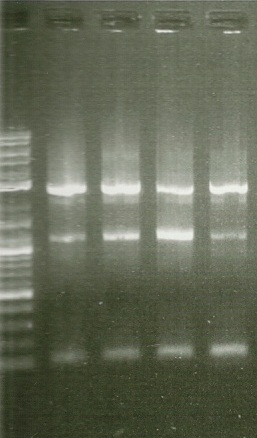
1st round PCR Gel (put in notebook section)
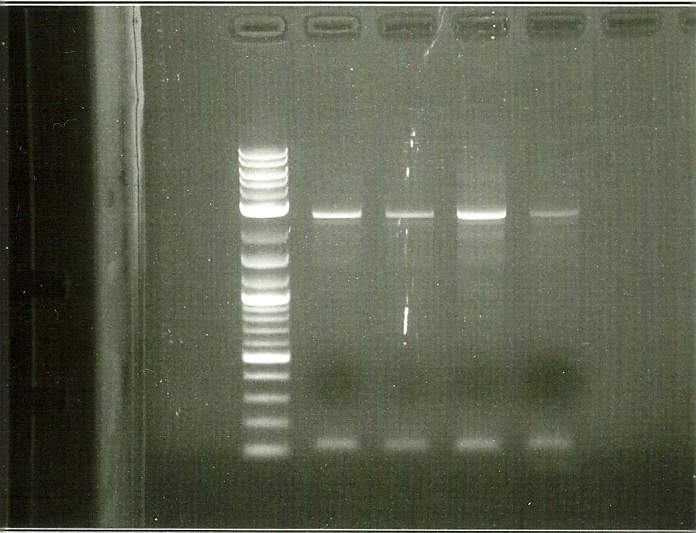
2nd round PCR Gel (leave here)

Strain 39 YB-mCherry RFP tagged expression (leave here)

Strain 39 Control (put in notebook section)

Strain 39 beta carotene production (leave here)

Strain 39 beta carotene production Control (put in notebook section)

 "
"









